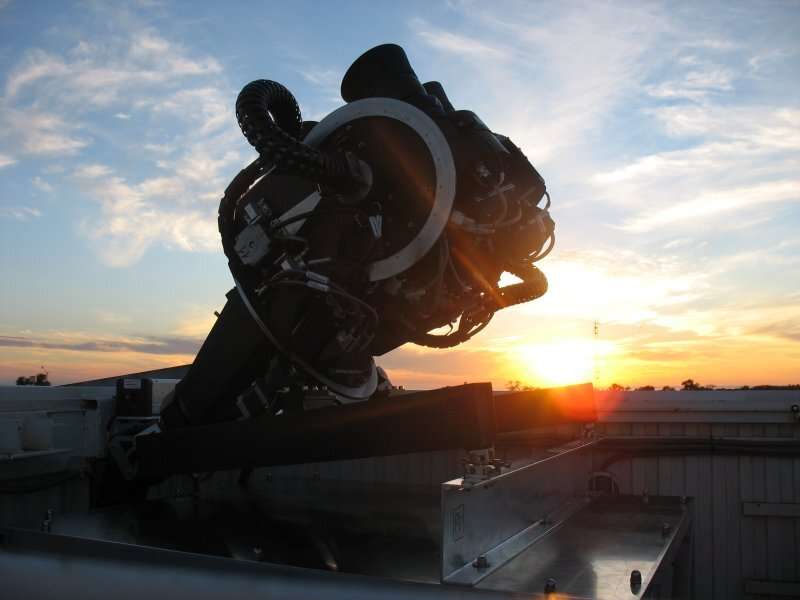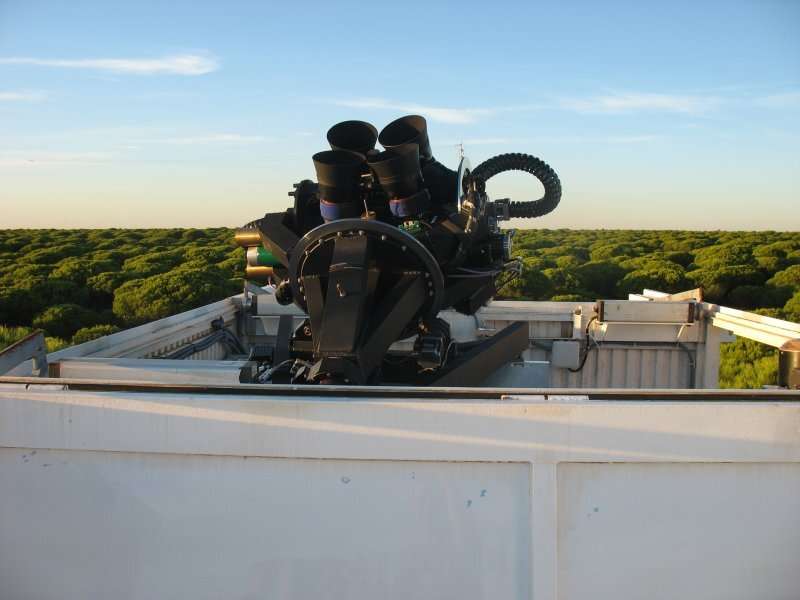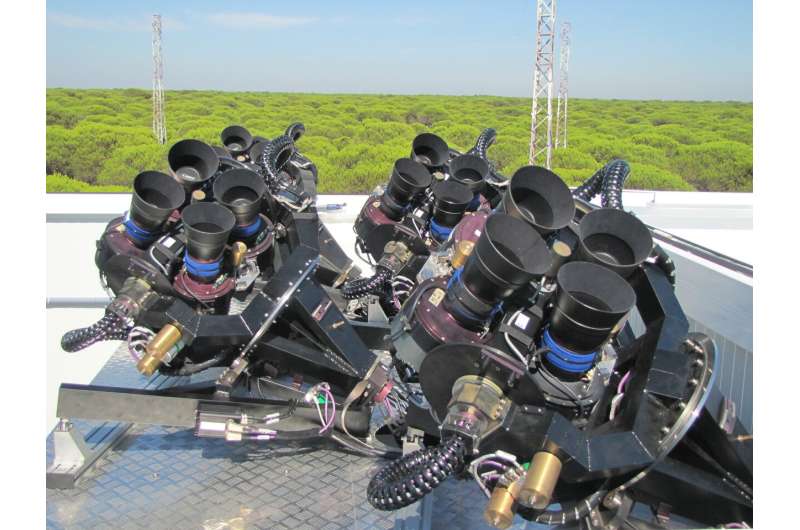Four of the Pi of the Sky Detector’s cameras. Credit: Marcin Sokołowski.
Strangelets, and specifically nuclearites, their heavy species, are very dense, compact and potentially fast objects made of large and roughly equal numbers of up, down and strange quarks, which may inhabit the universe. Their existence was first hypothesized by Edward Witten back in 1984. These objects have never been detected before and have so far attracted less attention than meteors, perhaps due to their lack of relevance in particle physics.
At the end of 1984, theoretical physicists Alvaro De Rujula and Sheldon Lee Glashow introduced the idea that, when crossing the Earth's atmosphere, nuclearites produce light in a similar way to meteors, losing very little of their energy in the process. If their prediction is right, teams working at meteor observatories should be able to confirm whether these objects exist or not. So far, however, very few researchers have conducted studies investigating this possibility.
A different cosmic phenomenon rooted in particle physics, known as ultra-high energy cosmic rays, shares some of the same theorized characteristics of nuclearites. These cosmic rays, in fact, also produce trails of light in the atmosphere, although they do this via a different physical process. In addition, they move much faster than nuclearities and are usually observed in the ultraviolet (UV) band.
Unlike nuclearities, ultra-high energy cosmic rays have been detected before. Nonetheless, they are a very rare phenomenon, with fluxes lower than 1 particle per square kilometer per 100 years for the highest energies. To detect them, scientists thus need to monitor large volumes of the atmosphere using big detectors, which could eventually also lead to the detection of nuclearities.
Researchers at RIKEN in Japan, the National Center for Nuclear Research in Poland, Aix Marseille University-CNRS, the Polish Academy of Sciences and University of Warsaw have recently carried out a search for nuclearities and other heavy compact objects based on photographic data collected by the "Pi of the Sky" detectors at the INTA El Arenosillo test center in Mazagaon near Huelva, Spain and at Las Campanas Observatory in Chile. Their paper, journals.aps.org/prl/abstract/ … ysRevLett.125.091101">published in Physical Review Letters, introduces a set of limits that could guide future searches for heavy compact objects in the universe.
"I came across the idea of observing nuclearites with a camera when I joined the JEM-EUSO collaboration, which intends to build an orbital UV telescope monitoring the Earth's atmosphere, looking mainly for cosmic rays, but also nuclearites, meteors and other phenomena," Lech Wiktor Piotrowski, one of the researchers who carried out the study, told Phys.org. "A much bigger volume of the atmosphere is visible from the orbit compared to the on-ground observatories, thus the chances of detection are increased by an order of magnitude."
The key objective of the recent study by Piotrowski and his colleagues was to discover nuclearities or other heavy compact objects crossing the atmosphere in photographs taken by the Pi of the Sky detectors, or to at least set limits on their flux, if their search yielded no positive results.
While the final UV telescope developed by the JEM-EUSO collaboration could aid the study of numerous cosmological phenomena, the researchers have not yet started using it to collect observations (although the data from smaller precursor experiments is currently being analyzed). In their recent study, they thus decided to use available ground data collected as part of the Pi of the Sky experiment.
The prediction that nuclearities produce light as they cross the atmosphere is based on estimations of their density and potential speed. This characteristic could thus be shared by other cosmological objects of different natures.
Since De Rujula and Glashow introduced their theory back in 1984, the list of objects that are hypothesized to leave light traces in the Earth's atmosphere has grown substantially, also including objects that are not directly relevant to the field of particle physics, such as small primordial black holes. While their search for nuclearities was fruitless, it allowed Piotrowski and his colleagues to set a series of limits that could narrow down future searches for both nuclearities and other heavy compact objects in the universe.
Four of the Pi of the Sky Detector’s cameras. The detector. Credit: Marcin Sokołowski.
"In high school, reading a popular article about hypothetical 'strangelets' and how they may destroy the world, convinced me that I should become a particle physicist," Piotrowski said. "I have become one, but in the process, I started to think that I will never have anything to do with those strangelets. Then, a few years later, thanks to the work I conducted as part of the JEM-EUSO collaboration, I found out that with archival data of my old sky-gazing experiment Pi of the Sky, I could make some substantial contribution to the topic of strangelets. This is how this paper was born."
The core idea behind the study carried out by Piotrowski and his colleagues is fairly simple. When one looks up at the sky at night, he/she should theoretically be able to see the tracks of nuclearites and other heavy compact objects, just like he/she sees those left by meteors or satellites.
The tracks left by nuclearites and other heavy compact objects, however, should be slightly different. A nuclearite should be able to pass through the whole atmosphere, thus the light trail it leaves would be very long and give off a constant brightness that only changes based on the physical distance with an observer. The researchers searched for these long trails in photographs taken as part of the Pi of the Sky experiment.
"Seeing such a track would give us a candidate, while a lack of any detections would allow us to set a limit on the flux of nuclearites and other heavy compact objects," Piotrowski explained. "This involves calculating the overall time of sky observations and an effective surface of the volume of the sky observed, which depends on the detector pointing, as well as on the assumption that the objects were coming from all possible directions, from a single direction or from some specific direction configurations. Finally, the limit needs to include the detection efficiency of the detector (which can be obtained through simulations), and information about how well we can distinguish between the objects of interest and other tracks, such as those coming from meteors and satellites."
The Pi of the Sky detector takes images of the sky using CCD cameras with commercial photographic lenses mounted on them, without any filters. It can therefore collect images that roughly reflect what a human observer would see when looking up at the sky.
The detector's exposures last approximately 10 seconds and its cameras follow the movement of the stars. It can thus also be used to gather information about how the volume of the atmosphere changed during the course of the night.
"During the Pi of the Sky experiment, we did not foresee any research related to tracks, and performed an automatic analysis of stars and star-like transients, after which most of the raw data was discarded," Piotrowski said. "The luckily remaining raw data, spanning through several years and cameras, was used for the analysis presented in our paper."
The researchers analyzed all the raw frames collected by the Pi of the Sky detector, discarding approximately 50% of them due to their poor quality. Subsequently, they searched for images of tracks in the remaining good quality frames, which included 1766.05 h of observations gathered by a single, 20x20 degree camera equivalent. Their search was conducted using a Hough-transform based algorithm specifically designed to identify tracks in images.
"We have identified almost 36,000 tracks in the data, most of which were automatically classified as meteors or satellites based mainly on the variability of their brightness (the brightness of a nuclearite should be almost constant), the remaining were filtered out manually, leaving 29 candidates," Piotrowski said. "Nine of those were found in a catalog of satellites, leaving 20 candidates. In future dedicated experiments, those candidates could be further classified based on their speed, which cannot be derived from the analyzed 10 second exposures."
As the data used by the researchers did not include any information related to speed, they were unable to determine whether the 20 candidates that they could not identify are in fact nuclearities or heavy compact objects. However, based on the data available to them, they think that the possibility of them being heavy compact objects is highly unlikely.
The Pi of the Sky Detector. Credit: Aleksander Filip Żarnecki.
"Almost all of the 20 remaining tracks are shorter than 500 pixels (our CCD is roughly 2000x2000 pixels), while for the nuclearites, we expect an almost flat distribution through all possible track lengths, limited almost only by the point of entry into the atmosphere and the edge of the field of view," Piotrowski explained. "The candidates are thus most likely satellites or meteors, with a portion of a track in our cameras too short to show the characteristic variability of brightness."
Based on the results they gathered so far, Piotrowski and his colleagues assume that the images they analyzed contain no traces of nuclearites or other heavy compact objects, thus they set out to place a limit on their flux based on the data available to them. To do this, they calculated the effective surface of the atmosphere's volume contained in each frame, which depended on the direction a camera pointed in, the hypothetical mass of nuclearites and the estimated efficiency of nuclearite detection using the camera's specific configuration.
The efficiency of nuclearite detection was calculated by superimposing representations of nuclearite tracks on real images of the sky and running the Hough-transform based track detection algorithm on this artificial/simulated data. As nuclearites have never been observed before, simulation tools are particularly useful for studying them and showing what they would look like.
Ultimately, the researchers changed the flux limit based on the "separation efficiency" (i.e., an estimated value that describes how well they would be able to tell nuclearite tracks apart from light trails produced by meteors, satellites and other commonly observed objects). This value was derived from the length distribution of the 20 tracks that they were unable to identify during their search.
"The curvature of our limit line comes from two factors," Piotrowski explained. "First, the lower the nuclearite mass, the dimmer it is and the lower the sensitivity of our detector. This effect dominates the lower masses, where the detection efficiency is very small. Second, the heavier the nuclearite, the higher in the atmosphere it can start emitting light. Thus, the volume of the atmosphere observed is bigger for heavier nuclearites, allowing for setting a better limit on the flux. This dominates the highest masses, where the detection efficiency becomes mass-independent."
Exotic states of matter that cannot be directly observed from Earth have been the focus of numerous past research studies. Unveiling new forms of matters that cross the atmosphere would have important implications for the study of physics, astrophysics, astronomy and potentially other scientific fields as well.
The limits on the flux of heavy compact objects set by Piotrowski and his colleagues could be an important step towards better understanding the nature of heavy compact objects. For instance, they could guide future studies investigating the existence of stable quark matter in the universe.
"We now also have an experimental confirmation that heavy compact objects in the given mass range cannot cross the atmosphere in large numbers," Piotrowski said. "This is a starting point for the verification of the specific models for each heavy compact object type and its possible source in the universe. But there is also a more mundane reason for the performed study. Up to now, it seems that no one had searched for heavy compact objects in the analyzed mass range; as scientists, we should explore such terra incognita, because often, something new lurks there. It didn't this time, not with our current sensitivity, but this was a first step."
The recent study carried out by this team of researchers also proves that purely astrophysical experiments could be of great value for the study of particle physics. While astrophysics and particle physics are closely related, in fact, the ideas introduced by Witten, Rujula and Glashow in 1984 have remained largely untested or addressed by particle physicists for several decades.
In the future, the paper authored by Piotrowski and his colleagues could inspire other teams worldwide to search for nuclearities or other heavy compact objects. Meanwhile, the researchers plan to continue exploring this topic as well, in order to further narrow down the search for elusive cosmological objects.
"The obtained limits could now be used and modified to put constraints on specific types of heavy compact objects and their distribution in the galaxy/universe," Piotrowski said. "Second, it is also important to improve on the limits. This will be done in future experiments: on-ground ones dedicated to the purpose of detecting heavy compact objects, and orbital ones observing huge volumes of the atmosphere."
More information: Lech Wiktor Piotrowski et al. Limits on the Flux of Nuclearites and Other Heavy Compact Objects from the Pi of the Sky Project, Physical Review Letters (2020). DOI: 10.1103/PhysRevLett.125.091101
Journal information: Physical Review Letters
© 2020 Science X Network


























